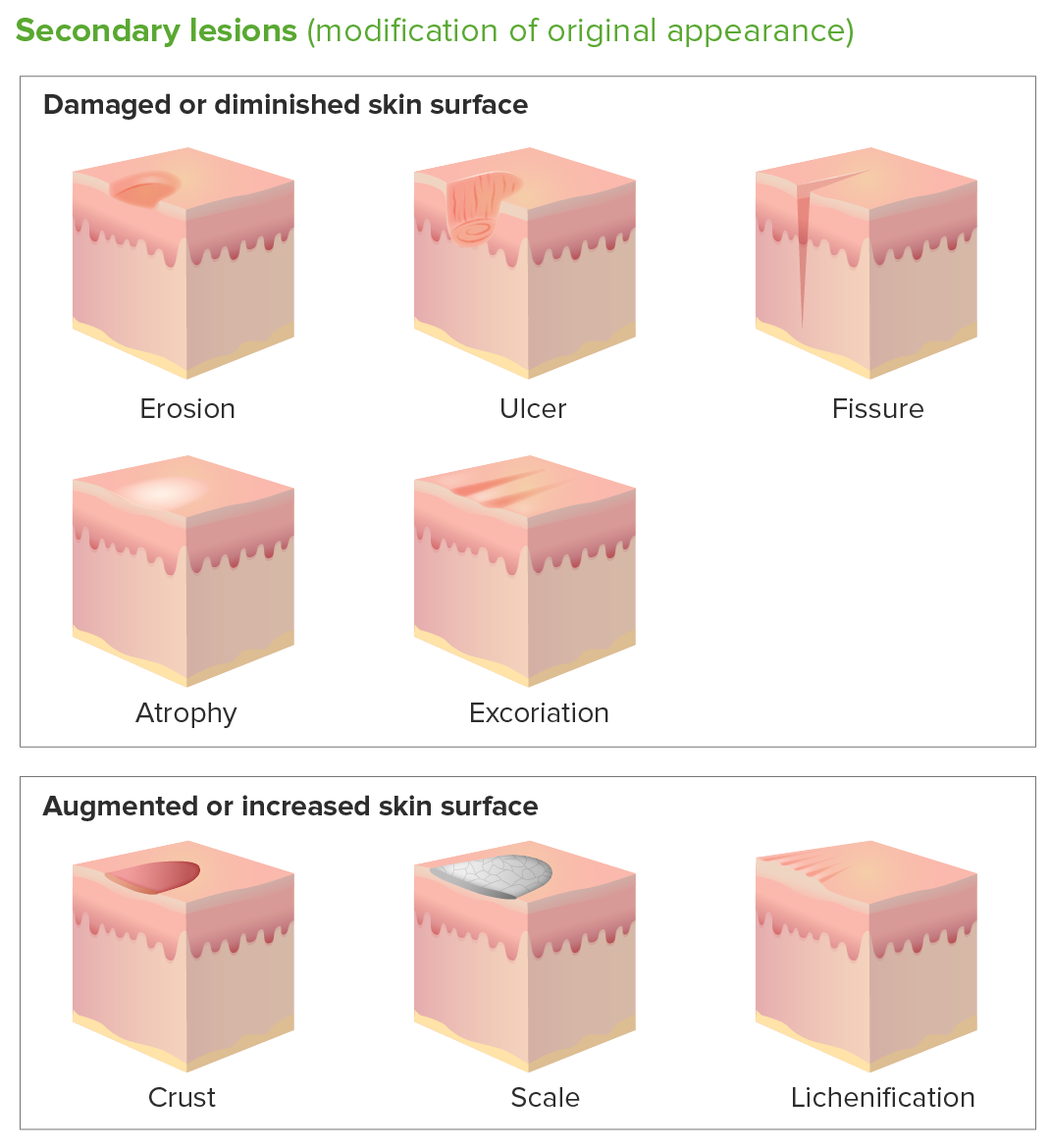Playlist
Show Playlist
Hide Playlist
Diagnostics in Dermatology: Skin Biopsy and Tzank Smear
-
Slides Diagnostics in Dermatology Skin Biopsy and Tzank Smear.pdf
-
Download Lecture Overview
00:01 So moving on to the next investigation, which is histopathology investigations in dermatology. This is what we use quite often actually what we call a skin biopsy. 00:12 We use a punch biopsy. 00:14 We've got different sizes of punches two millimeter up to about eight millimeters depending on the lesion that you want to isolate. 00:22 So the primary technique for obtaining diagnostic full thickness is the punch biopsy. This is performed using a circular blade or trephine attached to a pencil like blade. And if that is a lesion that's where you direct your punch biopsy. 00:38 And you try and rotate it clockwise. 00:41 It's faster and actually easy to use a punch biopsy. 00:45 However, there are conditions where the punch biopsy is not suitable because you want to go deep to the subcutaneous fat and the punch doesn't go very deep. 00:56 So sometimes we have to do an excision or incision. 01:00 We'll talk about that. 01:02 So once the procedure is done as you can see the cylindrical tissue has to be has to be handled with care so that you don't crush it so that the histopathology can have a proper look at your specimen. 01:16 Thereafter, the site of biopsy can be closed with possible one suture or two sutures, depending on the size of the punch that you have used. 01:25 A punch biopsy is a common technique for obtaining full thickness skin samples. 01:31 It uses a circular blade available in sizes from 2 to 8mm, depending on the lesion. 01:38 This tool allows for efficient and easy extraction, typically by rotating the blade clockwise. However, in some cases where deeper tissue samples are needed, a punch biopsy might not suffice. 01:52 In those situations, an excision or incision is required. 01:57 Once the sample is taken, it must be handled with care to avoid damaging it before it's sent for analysis. 02:04 The biopsy site is then closed with 1 or 2 sutures, depending on the punch size. 02:11 Another way of doing a biopsy is what we call socialization. 02:15 This is ideal for vesiculobullous disorders and for epidermal neoplasms like seborrheic keratosis. The next one procedure that we do is a wedge biopsy. 02:27 A wedge biopsy. 02:28 This is for large lesions, especially subcutaneous mycosis or squamous cell carcinomas or TB or panniculitis. 02:37 As I mentioned to you. 02:38 Another form of biopsy is what we call incisional biopsy. 02:42 And this we do to confirm a or confirming the diagnosis. 02:48 Mainly this is used when inflammatory dermatologic dermatosis is suspected. 02:54 Excisional biopsy as it's the word says excisional biopsy. 02:59 This is when we remove the lesion completely. 03:03 And this is preferred for a neoplasm where we suspect a cancer. 03:10 The technician processes the tissue and stains with H and E what we call hematoxylin and eosin. 03:16 And this is how the slide looks like when it's ready for microscopy. 03:21 For light microscopy, another way of processing the histology specimen is direct immunofluorescence. It's a procedure that illustrates the in vivo binding of antibodies to antigens in the skin or mucosa. 03:39 So when do you use direct immunofluorescence. 03:41 We use this for diagnosis of autoimmune blistering diseases connective tissue diseases della lichen planus as well as we can also look at the linear deposition of immunoglobulin G at the dermoepidermal junction, particularly for bullous conditions like pemphigoid. 04:01 So you get deposits of IgG with an intercellular pattern in the epidermis. 04:07 In pemphigus vulgaris, as you can see between the keratinocytes that we spoke about. That is where the immunoglobulins are detected. 04:17 Whereas in pemphigoid you see them at the demo epidermal junction. 04:22 And that is shown as a that linear fluorescent light. 04:26 Immunohistochemistry is also used where the presence or absence of certain proteins can form a basis for diagnosis for certain conditions. 04:36 This requires specific stains to identify different tumors and other neoplasms, for example, looking at the S100 stain for patients with melanoma. 04:48 As you can see there, that brown staining is confirming that that particular histology or biopsy has positive staining for S100. 04:59 Another form of investigation that we do is a zinc smear. 05:04 This is a simple and cheap test that relies on viewing and interpretation of cytology, which are single cells. 05:11 So we look at the cells to see how they are appearing after doing a zinc smear. 05:16 When do we do a zinc smear? We do this to detect a viral infections. 05:22 For example, herpes infection. 05:25 We also do it to distinguish between Stevens-Johnson syndrome and Staphylococcal scalded skin syndrome because these are different conditions that are treated differently. So sometimes we need urgent tests to differentiate between the two. 05:41 We also use it in differentiating between viral infections and blistering diseases. 05:47 So this we call the Tzanck smear. 05:50 Now let's take a look on how Zeng Smear is performed. 05:55 You gently roof the the blister, the roof of the blister. 06:01 You scrape the base of the lesion, not the roof, but the base of the lesion. 06:06 And then smear the tissue on your glass slide and you leave the smear to dry for a couple of minutes, and then apply the appropriate stain to stain the slide. 06:17 The findings on the Zeng smear depend on the type of pathology. 06:21 For example, the multinucleated giant cells, multiple cells coming together, are usually found in viral infections, for example in herpes infection. 06:32 After looking under the microscope.
About the Lecture
The lecture Diagnostics in Dermatology: Skin Biopsy and Tzank Smear by Ncoza Dlova is from the course Introduction to Dermatology.
Included Quiz Questions
What technique is used to obtain full-thickness skin specimens?
- Punch biopsy
- Shave biopsy
- Wedge biopsy
- Tzank smear
- Saucerization biopsy
What best describes a punch biopsy?
- Instrument is rotated down through skin and cylindrical tissue is sampled.
- Tissue is shaved off at the surface of the skin.
- A needle is inserted to aspirate cells.
- A small incision is made to remove a portion of the lesion.
- Tissue is scraped from the skin surface with a blade.
What best describes an incisional biopsy?
- Taking a portion of a lesion to confirm the diagnosis.
- Removing the entire lesion to confirm the diagnosis.
- Collecting only surface cells for diagnostic purposes.
- Using a needle to aspirate fluid from a cyst for analysis.
- Scraping off a portion of the top skin layers for a biopsy.
Customer reviews
5,0 of 5 stars
| 5 Stars |
|
5 |
| 4 Stars |
|
0 |
| 3 Stars |
|
0 |
| 2 Stars |
|
0 |
| 1 Star |
|
0 |




